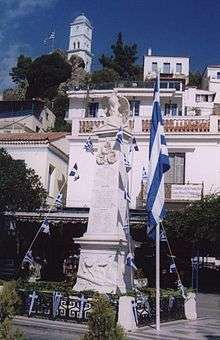Flag of Greece
 | |
| Names | "I Galanolefki" (The Blue and White), "I Kianolefki" (The Azure and White) |
|---|---|
| Use |
National flag and ensign |
| Proportion | 2:3 |
| Adopted | December 22, 1978 (Naval Ensign 1822–1978, National Flag 1969–70; 1978 to date) |
| Design | Nine horizontal stripes, in turn blue and white; a white cross on a blue square field in canton. |
The flag of Greece (popularly referred to as the "sky-blue-white" or the "blue-white" and in Greek: "Γαλανόλευκη" or "Κυανόλευκη"), officially recognised by Greece as one of its national symbols, is based on nine equal horizontal stripes of blue alternating with white. There is a blue canton in the upper hoist-side corner bearing a white cross; the cross symbolises Eastern Orthodox Christianity, the established religion of the Greek people of Greece and Cyprus. According to popular tradition, the nine stripes represent the nine syllables of the phrase "Ελευθερία ή Θάνατος" ("Freedom or Death"), the five blue stripes for the syllables "Έλευθερία" and the four white stripes "ή Θάνατος". The nine stripes are also said to represent the letters of the word "freedom" (Greek: Ελευθερία). There is also a different theory, that the nine stripes symbolise the nine Muses, the goddesses of art and civilisation (nine has traditionally been one of the numbers of reference for the Greeks).[1] The official flag ratio is 2:3.[2]
The blazon of the flag is Azure, four bars Argent; on a canton of the field a Greek cross throughout of the second. The shade of blue used in the flag has varied throughout its history, from light blue to dark blue, the latter being increasingly used since the late 1960s.
The above patterns were officially adopted by the First National Assembly at Epidaurus on 13 January 1822. Blue and white have many interpretations, symbolising the colours of the famed Greek sky and sea (combined with the white clouds and waves), traditional colours of Greek clothes in the islands and the mainland, etc.
History
The origins of today's national flag with its cross-and-stripe pattern are a matter of debate. Every part of it, including the blue and white colours (see below), the cross, as well as the stripe arrangement can be connected to very old historical elements; however it is difficult to establish "continuity", especially as there is no record of the exact reasoning behind its official adoption in early 1822.
It has been suggested by some Greek historians that the current flag derived from an older design, the virtually identical flag of two different families; the first was the Athanasiou Family and the second was the powerful Cretan Kallergis family. This flag was based on their coat of arms, whose pattern is supposed to be derived from the standards of their claimed ancestor, Byzantine Emperor Nicephorus II Phocas (963–969 AD). This pattern (according to not easily verifiable descriptions) included nine stripes of alternating blue and white, as well as a cross, assumed to be placed on the upper left.[3] Although the use of alternating blue and white - or silver - stripes on (several centuries-old) Kallergis' coats of arms is well documented, no depiction of the above described pattern (with the nine stripes and the cross) survives.
The stripe-pattern of the Greek flag is visibly similar to that used in several other flags that have appeared over the centuries, most notably that of the British East India Company's pre-1707 flag or the flag of the United States. However, in such cases of flags derived from much older designs, it is very difficult to prove or trace original influences.
Antiquity and the Byzantine Empire

Flags as they are known today did not exist in Antiquity. Instead, a variety of emblems and symbols (semeion, pl. semeia) were used to denote each state and were for example painted on the hoplite shields. The closest analogue to a modern flag were the vexillum-like banners used by ancient Greek armies, such as the so-called phoinikis, a cloth of deep red, suspended from the top of a staff or spear. It is not known to have carried any device or decoration though.
The Byzantines, like the Romans before them, used a variety of flags and banners, primarily to denote different military units. These were generally square or rectangular, with a number of streamers attached.[4] Most prominent among the early Byzantine flags was the labarum. In the surviving pictorial sources of the middle and later Empire, primarily the illustrated Skylitzes Chronicle, the predominating colours are red and blue in horizontal stripes, with a cross often placed in the centre of the flag. Other common symbols, prominently featuring on seals, were depictions of Christ, the Virgin Mary and saints, but these represent personal rather than family or state symbols. Western European-style heraldry was largely unknown until the last centuries of the Empire.[5]
There is no mention of any "state" flag until the mid-14th century, when a Spanish atlas, the Conosçimiento de todos los reynos depicts the flag of "the Empire of Constantinople" combining the red-on-white Cross of St George with the "tetragrammatic cross" of the ruling house of the Palaiologoi, featuring the four betas or pyrekvola ("fire-steels") on the flag quarters representing the imperial motto Βασιλεύς Βασιλέων Βασιλεύων Βασιλευόντων ("King of Kings Reigning over those who Rule").[6] The tetragrammatic cross flag, as it appears in quarters II and III in this design, is well documented. In the same Spanish atlas this "plain" tetragrammatic cross flag is presented as (among other places in the Empire) "the Flag of Salonika" and "the real Greece and Empire of the Greeks (la vera Grecia e el imperio de los griegos)". The (quartered) arrangement that includes the Cross of St. George is documented only in the Spanish atlas, and most probably combines the arms of Genoa (which had occupied Galata) with those of the Byzantine Empire, and was most probably flown only in Constantinople. Pseudo-Kodinos records the use of the "tetragrammatic cross" on the banner (phlamoulon) borne by imperial naval vessels, while the megas doux displayed an image of the emperor on horseback.[7]
Ottoman period
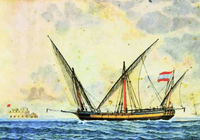
During the Ottoman rule several unofficial flags were used by Greeks, usually employing the Byzantine double-headed eagle (see below), the cross, depictions of saints and various mottoes. The Christian Greek sipahi cavalry employed by the Ottoman Sultan were allowed to use their own, clearly Christian flag, when within Epirus and the Peloponnese. It featured the classic blue cross on a white field with the picture of St. George slaying the dragon, and was used from 1431 until 1639, when this privilege was greatly limited by the Sultan. Similar flags were used by other local leaders. The closest to a Greek "national" flag during Ottoman rule was the so-called "Graeco-Ottoman flag" (Γραικοθωμανική παντιέρα), a civil ensign Greek Orthodox merchants (better: merchants from the Greek-dominated Orthodox millet) were allowed to fly on their ships, combining stripes with red (for the Ottoman Empire) and blue (for Orthodoxy) colours. After the Treaty of Küçük Kaynarca, Greek-owned merchant ships could also fly the Russian flag.
During the uprising of 1769 the historic blue cross on white field was used again by key military leaders who used it all the way to the revolution of 1821. It became the most popular Revolution flag, and it was argued that it should become the national flag. The "reverse" arrangement, white cross on a blue field, also appeared as Greek flag during the uprisings. This design had been used earlier as well, as a local symbol (a similar 16th or 17th century flag has been found near Chania), while Greek volunteers in Napoleon's army in Egypt in 1798 used a white cross on blue incorporated in the canton of the French flag.[8]
A military leader, Yiannis Stathas, used a flag with white cross on blue on his ship since 1800. The first flag featuring the design eventually adopted was created and hoisted in the Evangelistria monastery in Skiathos in 1807. Several prominent military leaders (including Theodoros Kolokotronis and Andreas Miaoulis) had gathered there for consultation concerning an uprising, and they were sworn to this flag by the local bishop.[1]
-

 Flag used by the Greek sipahis of the Ottoman army between 1431 and 1619
Flag used by the Greek sipahis of the Ottoman army between 1431 and 1619 -

 Civil flag and ensign of the Principality of Samos (1835–1912)
Civil flag and ensign of the Principality of Samos (1835–1912) -

 Flag of the Septinsular Republic (1800–1807), the first autonomous modern Greek state
Flag of the Septinsular Republic (1800–1807), the first autonomous modern Greek state -

 National flag and ensign of the Cretan State
National flag and ensign of the Cretan State -

 Flag of the Free State of Icaria
Flag of the Free State of Icaria
War of Independence
-

The flag of Greece as drawn by Rigas Feraios in his manuscripts.
-

Bishop Germanos of Patras blessing the flag of the Greek revolutionaries at the Monastery of Agia Lavra, part of a popular legend regarding the start of the revolution of 1821, although it never actually happened.
Prior and during the early days of the Greek War of Independence (1821–1829), a large variety of flags was designed, proposed and used by various Greek intellectuals in Western Europe, local leaders, chieftains and regional councils. Aside from the cross, many of these flags featured saints, the phoenix (symbolising the rebirth of the Greek nation), mottoes such as "Freedom or Death" (Ελευθερία ή Θάνατος) or the fasces-like emblems of the Philiki Etaireia, the secret society that organised the uprising.
-
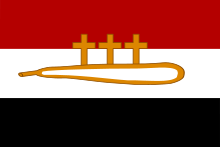
 The Flag of Greece, as proposed by Rigas Feraios in 1797
The Flag of Greece, as proposed by Rigas Feraios in 1797 -

 Flag of the Sacred Band
Flag of the Sacred Band -
.svg.png)
 The flag of Alexander Ypsilantis
The flag of Alexander Ypsilantis -

 Flag of the Areopagus of Eastern Continental Greece
Flag of the Areopagus of Eastern Continental Greece -
.svg.png)
 The flag of Andreas Londos
The flag of Andreas Londos -

 Flag of the Filiki Eteria
Flag of the Filiki Eteria -
.svg.png)
 Flag of the Maniots
Flag of the Maniots -

 Very widespread flag used from 1769 to the War of Independence
Very widespread flag used from 1769 to the War of Independence -

 The first flag of admiral Andreas Miaoulis
The first flag of admiral Andreas Miaoulis -

 Flag of Anthimos Gazis
Flag of Anthimos Gazis -

 Used in Thessaly, created also by Anthimos Gazis
Used in Thessaly, created also by Anthimos Gazis -

 Flag of Hydra island
Flag of Hydra island -

 Flag of Spetses island
Flag of Spetses island -
.svg.png)
 Flag of Chalkidiki
Flag of Chalkidiki -

 Flag of Athanasios Diakos
Flag of Athanasios Diakos
Adoption
Because the European monarchies, allied in the so-called "Concert of Europe", were suspicious towards national or social revolutionary movements such as the Etaireia, the First Greek National Assembly, convening in January 1822, took steps to disassociate itself from the Etaireia's legacy and portray nascent Greece as a "conventional", ordered nation-state.[1] As such not only were the regional councils abolished in favour of a central administration, but it was decided to abolish all revolutionary flags and adopt a universal national flag. The reasons why the particular arrangement (white cross on blue) was selected, instead of the more popular blue cross on a white field, remain unknown.[1]
On 15 March 1822, the Provisional Government, by Decree Nr. 540, laid down the exact pattern: white cross on blue (plain) for the land flag; nine alternate-coloured stripes with the white cross on a blue field in the canton for the naval ensign; and blue with a blue cross on a white field in the canton for the civil ensign (merchant flag).[1][2] On 30 June 1828, by decree of the Governor Ioannis Kapodistrias, the civil ensign was discontinued, and the cross-and-stripes naval ensign became the national ensign, worn by both naval and merchant ships.[1] This design became immediately very popular with Greeks and in practice was often used simultaneously with the national (plain cross) flag.
-
.svg.png)
 State flag on land, 1822–1969 and 1975–78
State flag on land, 1822–1969 and 1975–78 -

National flag for use abroad and as the civil ensign. Since 1978 the sole national flag of Greece
-

 Civil ensign used from 1822 to 1828
Civil ensign used from 1822 to 1828
Historical evolution
.png)
After the establishment of the Kingdom of Greece in 1832, the new king, Otto, added the royal Coat of Arms (a shield in his ancestral Bavarian pattern topped by a crown) in the centre of the cross for military flags (both land and sea versions).[2] Additionally, the ratios of the country's flags were set to 7:10 for the state flag and 18:25 for the state and naval ensign by a decree dated 3 June 1833.[9] After Otto's abdication in 1862, the royal coat of arms was removed, only to be replaced by a simple royal crown in 1863 when the new king, George I, arrived in Greece. A square version of the land flag with St. George in the centre was adopted on 9 April 1864 as the Army's colours.[1] Similar arrangements were made for the royal flags, which featured the coat of arms of the House of Schleswig-Holstein-Sonderburg-Glücksburg on a square version of the national flag. The exact shape and usage of the flags was determined by Royal Decree on 26 September 1867.[1] By a new Royal Decree, on 31 May 1914, the flag with the crown was adopted for use as a state flag by ministries, embassies and civil services, while the sea flag was allowed for use by private citizens.[1]
On 25 March 1924, with the establishment of the Second Hellenic Republic, the crowns were removed from all flags.[1] On 20 February 1930, the national flag's proportions were established at a 2:3 ratio, with the arms of the cross being "one fifth of the flag's width". The land version of the national flag was to be used by ministries, embassies, and in general by all civil and military services, while the sea flag was to be used by naval and merchant vessels, consulates and private citizens. With the restoration of the monarchy by Georgios Kondylis on 10 October 1935, the crown was restored on the flags.[1] The crown was again removed by the military dictatorship in 1967, following the aborted counter-coup and subsequent self-exile of King Constantine II on 13 December. The sea flag was established as the sole national flag in 1969, using a very dark shade of blue, and on 18 August 1970, the flag ratio was changed to 7:12.[1]
After the restoration of democracy in August 1974, the land flag was restored for a while (Law 48/1975 and Presidential Decree 515/1975) until 1978.[1]
-
.svg.png)
 State flag (1833–1858)
State flag (1833–1858)
Proportions: 7:10 -
.svg.png)
 Naval ensign (1833–1858)
Naval ensign (1833–1858)
Proportions: 18:25 -
.svg.png)
 State flag (1858–1862)
State flag (1858–1862)
Proportions: 2:3 -
.svg.png)
 Naval ensign (1858–1862)
Naval ensign (1858–1862)
Proportions: 2:3 -
.svg.png)
 State flag (1863–1924 and 1935–73)
State flag (1863–1924 and 1935–73) -
.svg.png)
 Naval ensign (1863–1924 and 1935–73)
Naval ensign (1863–1924 and 1935–73) -
.svg.png)
 National flag (1970–1975)
National flag (1970–1975)
Theories regarding the blue and white colours
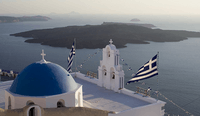
Several Greek researchers[3][10][11] have attempted to establish a continuity of usage and significance of the blue and white colours, throughout Greek history.
Usages cited include the pattern of blue and white formations (created from placing white metal layers on a blue surface) on the shield of Achilles,[10] the connection of the colours with goddess Athena, Alexander the Great's army banners,[3] blue and white flags supposedly used during Byzantine times,[10] supposed coats of arms of imperial dynasties and noble families, uniforms, emperors' clothes, patriarchs' thrones etc.[3][11] and, of course, cases of usage during the Ottoman rule.
Current flag of Greece
.svg.png)
.svg.png)
.svg.png)
.svg.png)
In 1978 the sea flag was adopted as the sole national flag, with a 2:3 ratio.[12] The flag is used on both land and sea is also the war and civil ensign, replacing all other designs surviving until that time. No other designs and badges can be shown on the flag. To date, no specification of the exact shade of the blue colour of the flag has been issued. Consequently, in practice hues may vary from very light to very dark. The Greek Flag Day is on October 27.
The old land flag is still flown at the Old Parliament building in Athens, site of the National Historical Museum, and can still be seen displayed unofficially by private citizens.
Protocol

The use of the Greek flag is regulated by Law 851.[13] More specifically, the law states that:
- When displayed at the Presidential Palace, the Hellenic Parliament, the ministries, embassies and consulates of Greece, schools, military camps, and public and private ships as well as the navy, the flag must:
- Fly from 8am until sunset,
- Be displayed on a white mast topped with a white cross on top of a white sphere,
- Not be torn or damaged in any way. If the flag is damaged, it should be burned in a respectful manner.
- The flag can be displayed by civilians on days specified by the ministry of internal affairs, as well as in sporting events and other occasions of the sort.
- When displayed vertically, the canton must be on the left side of the flag from the point of view of the spectator.
- The flag should never be:
- Defaced by means of writing or superimposing any kind of image or symbol upon it,
- Used to cover a statue. In that case, cloth in the national colours must be used,
- Hung from windows or balconies without the use of a mast,
- Used for commercial purposes,
- Used as a logo for any corporation or organization, even at different proportions.
- When placed on top of a coffin, the canton must always be on the right of the person's head.
Colours
The government has not specified exactly which shade of blue should be used for the flag, and as such flags with many varying shades exist. In the most recent legislation regarding the national flag, the colours mentioned are:
The National Flag of Greece is cyan and white, it is made up of nine (9) stripes equal in width, of which five (5) are cyan and four (4) are white so that the upper and lower stripes are cyan and the others inbetween are white.
Law 851/1978, Regarding the National Flag, Article 1, Clause 1
Because of the use of the word 'cyan' (Greek: Κυανός, Kyanos), which can also mean 'blue' in Greek, the exact shade of blue remains ambiguous. Although it implies the use of a light shade of blue, such as on the flag of the United Nations, the colours of the Greek flag tend to be darker, especially during the dictatorship and in recent years, with the exception of the years of the rule of King Otto, when a very light shade of blue was used. Consequently, the shade of blue is largely left to the flagmakers to decide, as shown in the table below.
| Official colour (White) | Official colour (Blue) | Colour system | Source | Year | URL |
|---|---|---|---|---|---|
| NA | 286 C | Pantone | Album des Pavillons | 2000 | [14] |
| NA | 100% - 60% - 0% - 5% | CMYK | Album des Pavillons | 2000 | [14] |
| NA | 285 | Pantone | 2008 Summer Olympics Flag Manual | 2008 | [15] |
| NA | Reflex Blue | Pantone | 2012 Summer Olympics Flag Manual | 2012 | [16] |
Flag days
Law 851/1978 sets the general outline for when the specific days on which the flag should be raised. Raising the flag on national or local public holidays is mandatory for everyone, from 8am until sunset.[13] For national holidays, this applies country-wide, but on local ones it only applies to those areas where the said holiday is being celebrated.[13] Additionally, the flag may also be flown on days of national mourning, half-mast. The Minister of the Interior has the authority to proclaim flag days if they are not already proclaimed, and proclaiming regional flag days is vested with the elected head of each regional unit (formerly prefectures).[13]
| Date | Name | Reason |
|---|---|---|
| 25 March | 25th of March | Anniversary of the traditional start date for the Greek War of Independence.[17] |
| 28 October | Ochi Day (No Day) | Anniversary of the refusal to accept the Italian ultimatum in 1940.[17] |
| 17 November | Polytechnic Day | Anniversary of the Athens Polytechnic uprising against the military junta (school holiday).[18] |
Although November 17 is not an official national holiday, Presidential Decree 201/1998 states that respects are to be paid to the flag on that particular day.[18]
Military flags
Army and Air Force War Flag
The War flag (equivalent to regimental colours) of the Army and the Air Force is of square shape, with a white cross on blue background. On the centre of the cross the image of Saint George is shown on Army war flags and the image of archangel Michael is shown on Air Force war flags.[2]
In the Army war flags are normally carried by infantry, tank and special forces regiments and battalions, by the Evelpidon Military Academy, the Non-Commissioned Officers Academy and the Presidential Guard when in battle or in parade.[19] However, flying a war flag in battle is unlikely with current warfare tactics.
-

Army regimental war flag
-

Flag of the Hellenic Army General Staff
-
.svg.png)
 Air Force and civil air ensign, 1973–1978
Air Force and civil air ensign, 1973–1978
The current naval and civil ensigns are identical to the national flag.
The simple white cross on blue field pattern is also used as the Navy's jack and as the base pattern for naval rank flags. These flags are described in Chapter 21 (articles 2101–30) of the Naval Regulations. A jack is also flown by larger vessels of the Hellenic Coast Guard.
Units of Naval or Coast Guard personnel in parade fly the war ensign in place of the war flag.[20]
-

Naval jack of Greece
-
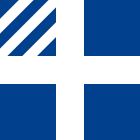
Naval rank flag of the Prime Minister of Greece
-
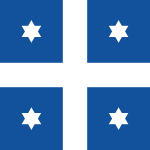
Naval rank flag for a full Admiral
-
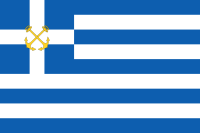
 Coast Guard ensign (1964–1980)
Coast Guard ensign (1964–1980)
In the past a war flag was assigned to the former semi-military Hellenic Gendarmerie, which was later merged with Cities Police to form the current Hellenic Police. The flag was similar to the Army war flag but showing Saint Irene in place of Saint George.[20]
Since the Fire Service and the Hellenic Police are considered civilian agencies, they are not assigned war flags. They use the National Flag instead.[21] Identical rules were applied to the former Cities Police. However, recently the Police Academy has been assigned a war flag, and they paraded for the first titme with this flag on Independence Day, March 25, 2011. The flag is similar to the Army war flag, with the image of St George replaced with that of Artemius of Antioch.[22]
Flag of the Head of State
Throughout the history of Greece, various heads of state have used different flags. The designs differ according to the historical era they were used in and in accordance with the political scene in Greece at the time. The first flag to be used by a head of state of Greece was that of King Otto of Greece. The current design, the flag of the President of Greece, was adopted in 1975.
-

 Flag of King Otto of Greece (1833–1862)
Flag of King Otto of Greece (1833–1862) -

 The Royal Standard of Greece (1863-1913)
The Royal Standard of Greece (1863-1913) -
.svg.png)
 Flag of King George I of Greece (1863–1913)
Flag of King George I of Greece (1863–1913) -
.svg.png)
 Flag of King Constantine I of Greece in his capacity as a Field Marshal (1913–1917 and 1920–1922)
Flag of King Constantine I of Greece in his capacity as a Field Marshal (1913–1917 and 1920–1922) -

 Royal standard of Greece (1935-1973)
Royal standard of Greece (1935-1973) -
.svg.png)
 Flag of the King of Greece (1935–1973)
Flag of the King of Greece (1935–1973) -
.svg.png)
 Flag of the President of Greece (1973–1974)
Flag of the President of Greece (1973–1974) -
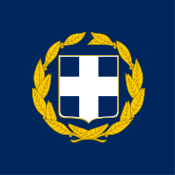
Flag of the President of Greece (1975–present)
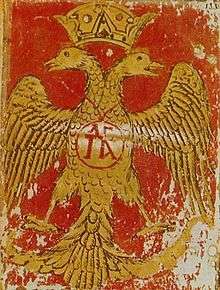
One of the most recognisable (other than the cross) and beloved Greek symbols, the double-headed eagle, is not a part of the modern Greek flag or coat of arms (although it is officially used by the Greek Army, the Church of Greece, the Cypriot National Guard and the Church of Cyprus, and was incorporated in the Greek coat of arms between 1925 and 1926). One suggested explanation is that, upon independence, an effort was made for political — and international relations — reasons to limit expressions implying efforts to recreate the Byzantine empire. Yet another theory is that this symbol was only connected with a particular period of Greek history (Byzantine) and a particular form of rule (imperial). More recent research has justified this view, connecting this symbol only to personal and dynastic emblems of Byzantine Emperors.
Greek scholars have attempted to establish links with ancient symbols: the eagle was a common design representing power in ancient city-states, while there was an implication of a "dual-eagle" concept in the tale that Zeus left two eagles fly east and west from the ends of the world, eventually meeting in Delphi, thus proving it to be the centre of the earth. However, there is virtually no doubt that its origin is a blend of Roman and Eastern influences. Indeed, the early Byzantine Empire inherited the Roman eagle as an imperial symbol. During his reign, Emperor Isaac I Comnenus (1057–59) modified it as double-headed, influenced by traditions about such a beast in his native Paphlagonia in Asia Minor (in turn reflecting possibly much older local myths). Many modifications followed in flag details, often combined with the cross. After the recapture of Constantinople by the Byzantine Greeks in 1261, two crowns were added (over each head) representing — according to the most prevalent theory — the newly recaptured capital and the intermediate "capital" of the empire of Nicaea. There has been some confusion about the exact use of this symbol by the Byzantines; it is quite certain that it was a "dynastic" and not a "state" symbol (a term not fully applicable at the time, anyway), and for this reason, the colours connected with it were clearly the colours of "imperial power", i.e., imperial purple and gold.
After the fall of Constantinople to the Ottoman Empire nonetheless, the double-headed eagle remained a strong symbol of reference for the Greeks. Most characteristically, the Orthodox Church continues to use the double-headed eagle extensively as a decorative motif, and has also adopted a black eagle on yellow/gold background as its official flag.
After the Ottoman conquest however this symbol also found its way to a "new Constantinople" (or Third Rome), i.e. Moscow. Russia, deeply influenced by the Byzantine Empire, saw herself as its heir and adopted the double-headed eagle as its imperial symbol. It was also adopted by the Serbs, the Montenegrins, the Albanians and a number of Western rulers, most notably in Germany and Austria.
-

 Flag of the Greek Orthodox Church
Flag of the Greek Orthodox Church -

 Flag of the Autonomous Republic of Northern Epirus (1914)
Flag of the Autonomous Republic of Northern Epirus (1914) -

 Flag of the Republic of the Pontus
Flag of the Republic of the Pontus -

Flag of the Hellenic Army General Staff
References
- 1 2 3 4 5 6 7 8 9 10 11 12 13 Alexander-Michael Hadjilyra: Η καθιέρωση της ελληνικής σημαίας ("The adoption of the Greek flag"), Hellenic Army General Staff, 2003
- 1 2 3 4 The Flag, from the site of the Presidency of the Hellenic Republic
- 1 2 3 4 N. Zapheiriou, Η Ελληνική Σημαία από τους αρχαίους χρόνους μέχρι σήμερα (The Greek Flag from Antiquity to Present), Eleftheri Skepsis, Athens 1995 (reprint of original 1947 publication) ISBN 960-7199-60-X
- ↑ Emperor Maurice, Strategikon, II.14
- ↑ Kazhdan, Alexander, ed. (1991). Oxford Dictionary of Byzantium. Oxford University Press. pp. 472, 999. ISBN 978-0-19-504652-6.
- ↑ Byzantine Heraldry, from Heraldica.org
- ↑ Kazhdan, Alexander, ed. (1991). Oxford Dictionary of Byzantium. Oxford University Press. pp. 472–473. ISBN 978-0-19-504652-6.
- ↑ History of Greek Flags
- ↑ Government of Greece (3 June 1833). "Περί της Πολεμικής και Εμπορικής Σημαίας του Βασιλείου" [Regarding the Naval and Commercial Flag of the Kingdom]. Government Gazette. Retrieved 18 August 2012.
- 1 2 3 V. Tzouras, Η Ελληνική Σημαία, Μελέτη Πρωτότυπος Ιστορική (The Greek Flag, Original Historic Study), A. Lantzas, Kerkyra 1909
- 1 2 E. Kokkoni and G. Tsiveriotis, Ελληνικές Σημαίες, Σήματα-Εμβλήματα (Greek Flags, Signs and Emblems), Athens 1997 ISBN 960-7795-01-6
- ↑ Law 851/21-12-1978 On the national Flag, War Flags and the Distinguishing Flag of the President of the Republic, Gazette issue A-233/1978.
- 1 2 3 4 Law 851 (in Greek)
- 1 2 Album des pavillons nationaux et des marques distinctives. Brest, France: S.H.O.M.; 2000. p. 238.
- ↑ Flag Manual. Beijing, China: Beijing Organizing Committee for the Games of the XXIX Olympiad – Protocol Division; 2008. p. B15.
- ↑ Flags and Anthems Manual. London, United Kingdom: London Organising Committee of the Olympic Games and Paralympic Games Limited; 2012. p. 47.
- 1 2 Procedural time limits - Greece
- 1 2 Presidential Decree 201/1998
- ↑ O. Zotiadis (January 2001). "Decorations of War Flags (Greek: Τιμητικές διακρίσεις πολεμικών σημαιών)". Military Review. Hellenic Army General Staff.
- 1 2 Presidential Decree 348 /17-4-1980, On the war flags of the Armed Forces and the Gendarmerie Corps, Gazette issue A-98/1980.
- ↑ Presidential Decree 991/7-10-1980, Specification of the size of the National Flag born by the Coast Guard, Cities Police and Fire Service and the length of its staff, Gazette issue A-247/1980.
- ↑ Σχολή Αξιωματικών Ελληνικής Αστυνομίας
- I. Nouchakis, Η Σημαία μας (Our Flag), Athens 1908.
External links

 Media related to Flags of Greece at Wikimedia Commons
Media related to Flags of Greece at Wikimedia Commons- Flags of Greece at Flags of the World
- Presidency of the Hellenic Republic: State Symbols, The Flag
- Historical Flags of Greece
- Article on the Greek Flag from the website of the Hellenic Army (Greek)
- Older article on the Greek Flag from the website of the Hellenic Army (Greek)
- Greek flags during the Ottoman era (Greek)
- From the Official Website of Greek Presidential Guard
- Decrees specifying the design of the flag:
- Regarding the Naval and Commercial Flag of the Kingdom (3 June 1833) - contains official drawings
- Regarding the Naval and Commercial Flag (13 September 1858)
- Regarding the Flags of the Kingdom of Greece and other distinctive ensigns (31 May 1914) - contains official drawings
- Regarding the flag of Greece and other distinctive ensigns (25 February 1930)
- Law 48 Regarding the National Flag of Greece, the Emblem of the Hellenic Republic, etc (7 June 1975)
- Law 851 Regarding the National Flag, the War Flags and the Emblem of the President of the Republic (22 December 1978) - current
Symbols of Greece | |||||||
|---|---|---|---|---|---|---|---|
| National symbols |
|  | |||||
| Other symbols |
| ||||||
| Natural | |||||||
| Monuments | |||||||
| Music | |||||||
| National poets |
| ||||||
| National epics |
| ||||||
| Cuisine | |||||||
| Patron Saints | |||||||
| Former national symbols | |||||||
| Related |
| ||||||
_Merchant_Flag_1453-1793.svg.png)
